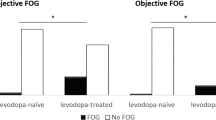Summary.
Background. Freezing of Gait (FOG) is one of the most disturbing and least understood symptom in advanced stage of Parkinson's disease (PD). The contribution of the underlying pathological process and the antiparkinsonian treatment to the development of FOG are controversial.
Objective. To study the relationships between clinical features of PD and therapeutic modalities in patients with advanced PD and FOG.
Methods. Consecutive patients with 5 years or more of PD symptoms (n = 172) (99 men) with mean age at symptoms onset of 58.3 ± 13.2 years and mean symptoms duration of 11.8 ± 5.6 years were studied. Clinical data were collected during the last office visit through physical examination, detailed history, review of patients' charts, and other documents. A patient was considered as "freezer" if he/she reported recent experience that the legs got stuck to the ground while trying to walk. The presence of dyskinesia, early morning dystonia or significant postural reflex abnormalities were assessed through history and neurological examination. Duration of treatment with antiparkinsonian drugs was calculated from history charts. Chi square and t test were used to compare the patients with and without FOG. Logistic regression was used for the comparison of association between the presence of FOG (dependent variable) disease duration and disease stage (explanatory variables) and duration of treatment with anti-parkinsonian drugs.
Results. The study population consisted of 45 patients at Hoehn and Yahr (H&Y) stage 2.5 (26%), 104 patients at stage 3 (60.5%), and 23 patients at H&Y stages 4–5 (13.5%). Ninety one patients (53%) reported FOG at the time of the study. Severity of the disease expressed by H&Y stage at "off" was a significant contributing factor for FOG with a significant trend (z = 4.38, p < 0.0001), as was longer duration of levodopa treatment, and confirmed by FOG using the multivariate logistic regression (p = 0.01 and p = 0.004, respectively). Using a univariate model, longer duration of treatment with dopamine agonists contribute to the appearance of FOG (p = 0.07) while longer duration of amantadine treatment decreased the appearance of FOG (p = 0.09). There was a significant association between FOG and the presence of dyskinesia (p < 0.002), early morning foot dystonia (p < 0.003) and significant postural instability (p < 0.0005).
Conclusion. FOG is a common symptom in advanced PD. It is mainly related to disease progression and levodopa treatment.
Similar content being viewed by others
Author information
Authors and Affiliations
Additional information
Received April 19, 2000; accepted June 6, 2000
Rights and permissions
About this article
Cite this article
Giladi, N., Treves, T., Simon, E. et al. Freezing of gait in patients with advanced Parkinson's disease. J Neural Transm 108, 53–61 (2001). https://doi.org/10.1007/s007020170096
Issue Date:
DOI: https://doi.org/10.1007/s007020170096



